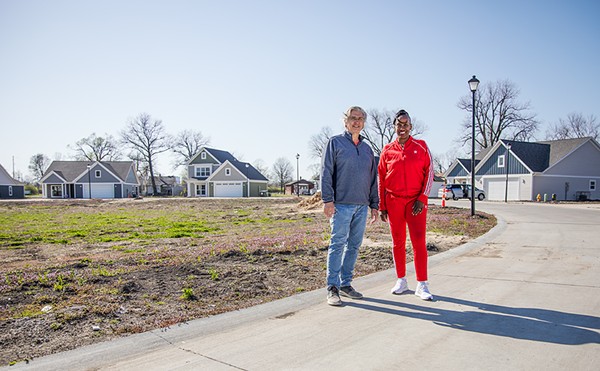What's sure is that the dead rested in peace for 1,000 years or so, enfolded in the earth they'd loved as their mother.
Then a bulldozer tore into that earth.
Fenton needed a Wal-Mart Supercenter.
Everybody in Fenton knew that the hillocks above Mound Street were burial mounds. But by the time city residents got wind of plans to destroy them, developer Gary Grewe had contracted to build a bigger and better Wal-Mart on the site.
Missouri is the heart of Wal-Mart country. The world's first supercenter was built in Washington, Mo., in 1988; the 1,000th was christened in St. Robert, Mo., in August 2001. Grewe's Fenton Supercenter slid neatly into place in a $193 million redevelopment plan for Fenton's downtown, with $47 million in tax-increment financing subsidies for the bulldozing.
When we inquired about the archaeological significance of the latest Supercenter, Grewe offered a single comment: "We built a 1.3 million square foot shopping center that's the neatest thing ever built in St. Louis; it's the biggest. I don't like this line of questioning."
At the outset, the Missouri Department of Natural Resources, charged with historic preservation, had informed Grewe that any human remains would have to be removed. He hired an engineering firm, SCI, whose archaeologists mapped the site and started digging. They took samples, but they weren't authorized to do pollen and seed counts or radiocarbon dating or document the mound's layers or filter all the soil for bits of pottery, stone and animal bones. No skeletal analyst was on site to examine the bones, which are often so fragile they turn to powder when they're moved -- but can unlock a diary of stresses, diseases, diet, periods of hunger, age, gender and cultural practices.
SCI project director Karl Ruhmann can't comment because SCI signed a confidentiality agreement with the developer. But in the initial field plan submitted to the state, SCI wrote, "A report will be generated that details the biological, cultural, and physical characteristics of the remains." As it became obvious that no one was prepared to pay the attendant costs, the "scope of work" shrank. Contractually, SCI's obligation was a simple one: Get the human remains and get out.
Debra Magruder, who hired on with SCI's crew when the first mound was nearly excavated, says they did that one right. She says that during her first day on the job, in February 1999, the crew's members were shovel-scraping, just the way they're supposed to, lifting thin layers of dirt so they wouldn't miss or damage any artifacts. "But by the time they got to the second mound, where all the burials were, they were so crunched for time that they got approval from Cal [Rea, the state archaeologist overseeing the dig] to start chunking. We were standing on our shovels, picking up dirt and throwing it over our shoulders. There's no telling what got lost."
SCI was glad Magruder had no field experience, she says, "because field school teaches you to go slow, and they wanted us to go fast. It was pretty messy out there at times.
"Just before I started, a femur was found," she adds. "The story I heard was that the guy working in that area thought it was a tree root and used some root clippers and snapped it in half. Then, when they figured out it was a femur, they just covered it and left it, half sticking out, and a looter came and ripped it out of the mound." The femur was indeed protruding from within a stone box chamber. On Feb. 17, a survey crew lifted the tarp and found that someone had dug horizontally into the vault and stolen the bone.
Rea, who has left the DNR, didn't respond to queries about the Fenton dig. "We were told not to talk with anyone about what was going on," adds Magruder. She and five other crew members wrote a letter of complaint to the state, saying they'd been "told that the developer had no legal responsibility to excavate the mounds and he could blast through them if he wanted to."
In July of 1999, the excavation was pronounced finished, and as soon as the last truckload of bones was driven away, earth-movers leveled the mounds. No one had surveyed the periphery, so if there were bundle burials outside the mound -- as archaeologists had found at the Gateway Academy site in St. Louis -- the bones were crunched into dust.
Bones already uncovered by the dig were placed in 26 metal bank boxes and stored at SCI. On July 21, 1999, SCI archaeologist Joseph Galloy, worried that no official report was being prepared, sent a two-page summary of the findings to the DNR. Most of the burials had been found in the larger mound, he reported: "One grave box contained only a pair of articulated hand bones, reminding one of the beheaded and behanded individuals in Mound 72 at Cahokia." Two mass burials were found, one with a wooden crypt or charnel house that looks as if it burned halfway through mound construction. Most of the human remains -- roughly 50 sets -- were encountered beneath larger trees, which may have protected them from pot-hunters. Two bird bones speared one of the skulls. Large mussel shells, ceramics, shell beads and a drilled bear tooth were found in or above graves. The mounds could have been built anytime between the Late Woodland and Early Mississippian periods, 600-1400 AD.
The public never heard that information. But Chris Bury, a sweet-faced young mechanic with the Missouri Department of Transportation, took pictures before the mounds were flattened, and he salvaged some artifacts. Using both hands, he raises the lid of his treasure box and removes a pointed chert tool, streaked orange and gray. "It was built to fit in your hand," he says, resting the cushion of his right palm in the hollow. Wrapping his fingers around the stone, he rests the tips in indentations on the other side and drags the tool's sharp edge along his left forearm. "You could scrape skin, scrape bark -- see, it's been used; it's rough right there. And see how the edge is sliced out to clear room for the base of your hand?" He reaches into the box and brings out a second, smaller tool. "See, here's a broken one. They were made just alike. I found 'em right where the bulldozer went through."
Blue-eyed, towheaded Doug Canady fell in love with American Indians when his second-grade teacher covered the walls with their pictures. Now a 41-year-old civil engineer, he reads archaeological journals on the weekend and wonders passionately about the first Missourians. He first heard about the mound excavation in September 1999, from a construction-worker friend who'd toured the site. "He told me he picked up a human tooth off the ground and a project superintendent told him, 'Looks like you found yourself a souvenir,'" Canady recalls grimly. "By the time I drove up there, nothing was left but rubble."
Early in September, just before the Supercenter's scheduled grand opening, Canady forces himself to return to the site. Wal-Mart trucks are lined up like a neat child's toys; pop music is already blasting into a parking lot half-filled with trainees' cars. "I can't even get oriented," he mutters. "I'd say the mound was about 50 or 100 feet above the Tire & Lube Express." He walks toward the ridge, now two crescents of rough orange rock, sliced clean in half, with trees sticking up from their outline like a child's drawing. "I thought there was such respect for human remains," he sighs. "I always thought that was one thing that would pretty much stop a project."
Archaeologist Tim Baumann knew better: "You could have the most important site in the U.S., and if no burials were in the way they wouldn't have to pick up one artifact. As we speak, there are hundreds of sites being destroyed." A faculty member at the University of Missouri-St. Louis, Baumann serves on the DNR's Council for Historic Preservation. He learned about the project in the summer of 1999, too late to undo the damage.
"No serious archaeology's ever been done in that area," Baumann points out, "and nobody has excavated a mound this size, with the number of burials that came out of this one, in 20 or 30 years." Yet, as hungry as he is for the lost information, he maintains that, ideally, the graves should never have been touched, their souls' journeys never interrupted. They stood at the far edge of the bluff, he notes; why couldn't they have been fenced and preserved? They'd lend historic gravitas, attract sightseers. They might even bring a few more shoppers to Wal-Mart.
The human remains stayed in metal boxes at SCI for two years while their custodians argued. The DNR wanted the findings documented and reported to the public -- but wanted the developer, G.J. Grewe, to pay. That's the provision in most cultural-resource laws: The developer is benefiting from the destruction of cultural heritage, so the developer pays the costs of recovery, analysis, documentation and appropriate reburial.
Missouri's law, however, doesn't insist. Chapter 194's Unmarked Human Burial section suggests that all the right things be done as quickly as possible, but it doesn't spell out how, penalize delays or stipulate who pays.
"We believe our client has already gone above and beyond what is actually required by the Unmarked Human Burials Sites Act," Grewe's lawyer, Joseph G. Nassif of Thompson Coburn, wrote in October 2000. "If the State desires additional follow-up, the costs should be borne by the State."
The person now taking direct heat for the Fenton project, state archaeologist Judy Deel, didn't oversee it. Cal Rea did, but he's now in law school in Wisconsin; Deel jokes that this project drove him to it. Then, sighing, she recounts the state's limited and ineffective role, her soft, warm voice bending easily into apology: "We've had some ... um ... inquiries from the public, like 'If this is a burial ground, how did it happen that it was developed out of existence?' This -- did not go as smoothly as we could have wished."
If a single dollar of federal funding had trickled into the project, if a single patch of wetland had been compromised, if any federal agency had played even the most peripheral role, the National Historic Preservation Act would have provided rules, monitoring and accountability. An archaeological survey would have been done, efforts at preservation would have been made and, by executive order, a report would have been prepared for the president of the United States.
The DNR says the U.S. Army Corps of Engineers could have provided that kind of federal supervision by defining their purview more broadly. But Corps spokesman Charles Camillo says his agency found no impact on the waterways on the Wal-Mart side of Gravois Bluffs and only minimal impact on a creek on the other side.
"The Corps has been playing some funny games," says Joe Harl, co-founder of the Archaeological Research Center of St. Louis. He remembers projects in which the Corps broadened its involvement because "drainage" was affected, making archaeological salvage possible. But he also cites instances in which they've tried to pinpoint their responsibility to a single patch of wetland.
In Illinois, the state law echoes federal law so closely that federal involvement isn't needed. Mounds like Fenton's would be surveyed, their historic significance determined. If the site couldn't be preserved intact, the Illinois Historic Preservation Agency would work to mitigate any negative impact. Any findings would be studied and a report made to the public, all at the developer's expense and under the state's supervision.
Missouri law guarantees none of that.
Where were the Native American activists? Roughly 25 tribes once lived in Missouri, but they're all gone now, dispersed or destroyed or moved west. Today's political pressure comes from developers and their lobbyists.
Missouri has an Unmarked Human Burials Consultation Committee, with two Native American members, but because the committee's role is to advise on reburials, the group wasn't notified during the excavation. "I heard about it from area historians, not through the committee," says member Eddie Brown, a Pascua Yaqui tribesman and social-work professor who directs the Kathryn M. Buder Center for American Indian Studies at Washington University. "I brought it up at the last meeting. But you know the forces we're up against. There's going to be development, come hell or high water. The state is understaffed and busy with politics, and this has taken a very low priority."
The Osages, now in Oklahoma, are the most likely to claim the ancestral bones, simply because they lived here so long; many scholars believe they are direct descendants of the Mississippian mound-builders. But when the RFT called Carrie Wilson, who represents the Osage Nation under the Native American Graves Protection and Repatriation Act, the Fenton excavation came as a surprise. "Tell them the Osage tribe wants a report," she snapped, impatient with explanations of Missouri's inadequate laws. "At some point, the State Historic Preservation Office has to take responsibility. The Osage should have been consulted at the planning stages. Maybe we could have negotiated with the landowner to take this site out of play; maybe the state, or another organization, could have bought it. At least we could have looked at all the options."
Wilson takes a deep breath: "What Missouri has to understand is that this is Missouri's history. The Mississippi was the Nile, the cradle of American Indian civilization. There were more people living in the Mississippi area than anyplace else in the U.S. If you had an Egyptian pyramid, would you say, 'Sorry, private land, we're going to go ahead and destroy the site'? Missouri is sitting on a vast history that has never really been looked at, because it's too close to home."
The Fenton burial mounds haunted Canady for two years. Finally he was told by the DNR that the information had been classified to protect the (now bulldozed) site from looting. Bemused, he wrote in July to ask why the bones had been removed in such a fashion, why they hadn't been reburied yet, why no one would tell him anything. In August, he received a reply from deputy state historic-preservation officer Claire F. Blackwell, who called the Fenton project "an unfortunate example of the ambiguity of Chapter 194."
Meanwhile, Assistant Attorney General Shelley A. Woods wrote to SCI: "I understand that your company is refusing to turn certain human remains over to Missouri Department of Natural Resources staff, apparently because your company has not been paid by its client." SCI's Karl Ruhmann fired back: "We have been trying to get the State of Missouri to take possession of these humans for well over eight months.... The State had not, until this letter, shown much direct interest."
September was Missouri Archaeology Month. The DNR proudly distributed a new video, On the Trail of the First Americans and Missouri's Native American Heritage. Maybe it was inspirational: On Sept. 20, two years and two months after the excavation ended, the burial committee was informed that all obstacles had dissolved. The DNR had taken custody of the remains. "Judy [Deel] probably got in her truck and went and got them herself when people started asking questions," chuckles Gayle Fritz, a Wash. U. archaeologist who is new to the committee.
Until the Osage and other interested tribes have a chance to claim the remains, the bones will wait in acid-free boxes in what Deel calls a "secure location" in Jefferson City. Meanwhile, the DNR has finalized arrangements for a piece of land in a state park so that even if no tribe claims the remains, they can be unboxed and reverently returned to the earth.
"We might use a general pipe ceremony," muses Carter Revard, emeritus professor of English at Washington University. Revard grew up in an Osage town in Oklahoma and studied his heritage with a scholar's thirst. When he helped plan a reburial several years ago, he turned to the pipe as the symbol that binds all Native Americans in truth and reverence. "In effect, we pray," he explains, "asking that the dead be given a good way home, saying that now the earth has them back to her and they can be at peace."
Canady is relieved that the remains will be reburied, but he finds the ending bittersweet. "I wonder what future generations of Americans will think," he says, his square jaw set rigid. "Will they wish the high promontory with the Indian burial mound was still there, or will they be awash in thanks for the Wal-Mart Supercenter?"





